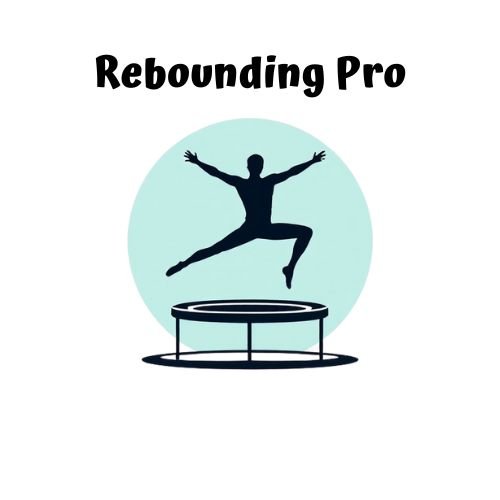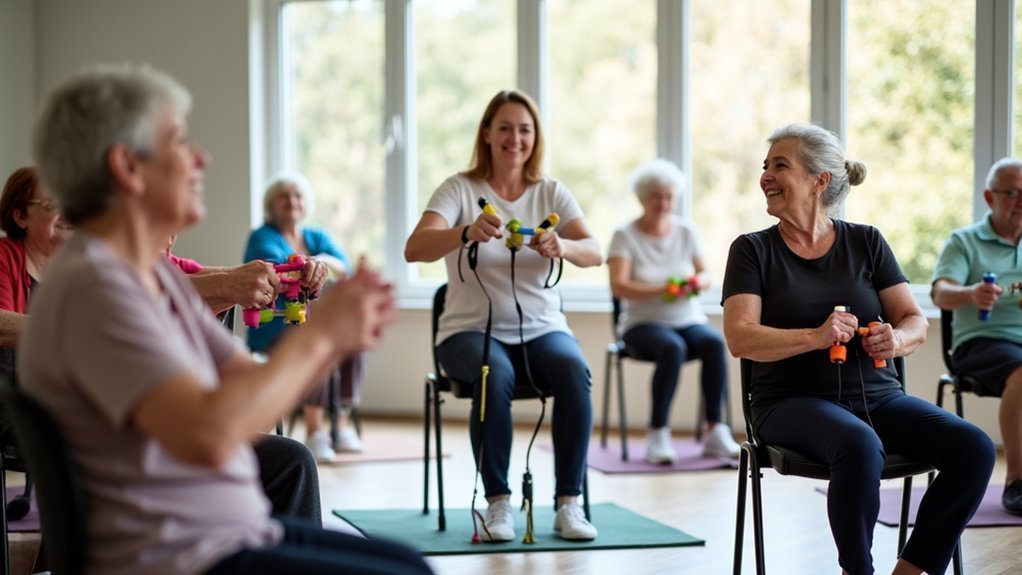Rebounding strengthens your heart muscle, making it pump blood more efficiently while lowering your resting heart rate. This gentle bouncing exercise increases cardiovascular endurance without straining joints, regulates blood pressure naturally, and enhances oxygen circulation throughout your body. You’ll also experience improved balance and coordination that support heart health, reduced stress levels, and increased lymphatic flow for toxin removal. Discover how just minutes a day on a mini-trampoline can transform your heart health completely.
7 Ways Rebounder Workouts Strengthen Your Heart

When you incorporate rebounding into your fitness routine, you’re giving your heart a thorough workout that few other exercises can match. The gentle bouncing motion strengthens your heart muscle, enabling it to pump more blood with each beat and lowering your resting heart rate.
Your cardiovascular system becomes more efficient as rebounding trains your heart to reach target exercise zones faster with less physical stress. You’ll notice improved endurance during daily activities as your heart works more effectively.
The rhythmic bouncing also enhances oxygen uptake throughout your body, delivering essential nutrients to cells while stimulating your lymphatic system. Rebounding exercises have been shown to provide significant improvements in health-related physical fitness and cardiovascular endurance compared to traditional workouts. This dual-action approach improves circulation while reducing inflammation.
As an added benefit, you’ll experience less joint strain than with high-impact exercises while still gaining significant cardiovascular improvements.
Boosting Cardiovascular Endurance Without Excessive Strain
Unlike high-impact exercises that can leave your joints aching, rebounding offers a gentler path to cardiovascular excellence. Each bounce on a rebounder increases your heart rate and enhances blood circulation without jarring your ankles, knees, or hips.
Bounce your way to better heart health without the joint strain of traditional cardio workouts.
The rhythmic motion of rebounding improves your heart’s pumping efficiency while simultaneously enhancing cellular oxygenation. Incorporating intervals of 40 seconds on followed by brief rest periods creates an effective pattern for cardiovascular conditioning. You’ll build stamina gradually as your cardiovascular system adapts to the consistent, low-impact challenge.
This makes rebounding ideal for those who need to limit stress on their joints but still want to strengthen their heart.
What makes rebounding particularly effective is how it improves cardiac function while minimizing injury risk. You’ll develop endurance that translates to everyday activities, all while preserving joint health for long-term fitness.
Natural Blood Pressure Regulation Through Rebounding

You’ll notice improved oxygen delivery to your cells during rebounding workouts, creating a natural pathway to better blood pressure regulation.
This cellular oxygenation helps counteract the effects of chronic stress, which often triggers hypertension by constricting blood vessels and increasing heart rate.
Regular mini-trampoline sessions can break this stress-hypertension cycle by activating your body’s relaxation response while simultaneously strengthening your cardiovascular system. The rhythmic muscle contractions during rebounding effectively lower blood pressure by encouraging healthy circulation throughout your body.
Cellular Oxygen Transport
Four critical oxygen redistribution mechanisms activate during rebounding exercises, promoting natural blood pressure regulation without medications.
Your body efficiently redirects up to 400 milliliters of oxygen per minute from your splanchnic region to active muscles without increasing cardiac output.
As you bounce, the acceleration-deceleration forces naturally open and close your lymphatic valves, enhancing waste removal and delivering fresh oxygen to cells.
This mechanical action stimulates endothelial nitric oxide production, dilating your blood vessels and reducing peripheral resistance.
Your mitochondria benefit from this oxygen-rich environment, producing ATP more efficiently for heart muscle function.
The improved vascular elasticity and capillary perfusion you’ll experience supports ideal oxygen saturation in tissues, creating conditions where your cardiovascular system can naturally maintain healthier blood pressure levels and overall heart function.
During rebounding aerobics, maximum oxygen extraction of 85 to 90 percent can be achieved in muscle cells during forty minutes of high-intensity bouncing.
Stress-Driven Hypertension Relief
When chronic stress tightens your vascular system, rebounding provides a direct pathway to natural blood pressure regulation through multiple physiological mechanisms. The rhythmic bouncing compresses your arteries and veins, improving circulation while strengthening your heart to pump more efficiently with fewer beats.
As you rebound, your body naturally balances hormones and neurotransmitters that regulate stress responses. The increased lymphatic flow removes toxins and inflammatory markers that contribute to hypertension. Rebounding has been shown to boost cardiovascular fitness, which directly correlates with lower blood pressure over time.
You’ll experience both immediate benefits through aerobic conditioning and long-term improvements in vascular resistance.
Start with just 5-10 minutes daily, gradually building to 20-60 minute sessions. Stay hydrated throughout to prevent blood pressure spikes.
The beauty of rebounding is its accessibility—you can easily incorporate this stress-relieving activity into your daily routine for consistent hypertension management.
Strengthening Your Heart Muscle With Each Bounce
Your heart muscle grows stronger with each session on the rebounder, developing a more durable myocardium that pumps blood more efficiently.
This enhanced cardiac strength allows your heart to circulate the same amount of blood with fewer beats, gradually lowering your resting heart rate. Regular rebounding exercise can effectively lower blood pressure by improving overall cardiovascular function.
You’ll notice improved cardiovascular endurance as your strengthened heart adapts to work less strenuously during both exercise and everyday activities.
Durable Myocardium Development
The heart muscle thrives on consistent aerobic activity, making rebounding an ideal exercise for cardiovascular development. With each bounce, you’re strengthening your heart, enabling it to pump more blood with fewer beats—a hallmark of improved cardiac efficiency.
Unlike high-impact exercises that stress joints, rebounding delivers intense workouts while protecting your body. The combination of increased blood flow and enhanced oxygen delivery works together to develop a more resilient myocardium over time. Rebounding is particularly effective because the up-and-down motion enhances lymphatic health while simultaneously benefiting the cardiovascular system.
- Your heart becomes more efficient at managing stress during physical activity
- Red blood cell production increases, improving oxygen delivery throughout your body
- Regular sessions contribute to potential blood pressure reduction as cardiovascular health improves
For lasting benefits, maintain consistency in your rebounding routine. This fun, sustainable exercise creates cumulative effects on heart health that traditional workouts often can’t match.
Lower Resting Heart Rate
Regular rebounding sessions directly contribute to a lower resting heart rate, one of the clearest indicators of improved cardiovascular fitness.
As you bounce consistently, your heart muscle strengthens and becomes more efficient at pumping blood throughout your body. This improved efficiency means your heart doesn’t need to work as hard during periods of rest. The lymphatic system benefits greatly from this movement since it lacks a pump and relies on physical activity to properly circulate.
Your strengthened heart pumps more blood with each contraction, requiring fewer beats to circulate the same volume of blood. This efficiency translates to a measurably lower heart rate when you’re inactive.
Studies show that rebounding workouts condition your heart to pump more powerfully while reducing perceived exertion. The cardiovascular improvements you’ll gain from rebounding don’t just support exercise performance—they decrease your risk of heart disease and potentially improve your longevity.
Joint-Friendly Cardio That Protects While It Strengthens

While high-impact exercises can leave joints aching and inflamed, rebounder workouts offer a revitalizing alternative that delivers cardiovascular benefits without the punishing effects.
The gentle bouncing motion minimizes stress on your knees, hips, and ankles while still elevating your heart rate for effective cardiovascular conditioning. Range-of-motion exercises help enhance flexibility and reduce stiffness, making rebounding an excellent choice for those with joint concerns.
Your joints benefit in multiple ways:
- The low-impact nature stimulates synovial fluid circulation, lubricating joints and reducing stiffness associated with arthritis or aging
- Strengthens muscles surrounding key joints, creating better support and stability during daily activities
- Improves balance and coordination, decreasing your risk of falls and acute joint injuries
You’ll build heart health without sacrificing joint health—allowing for consistent training without the painful recovery periods that often accompany high-impact cardio routines.
Maximizing Oxygen Circulation For Heart Health
Every bounce on a rebounder sets off a cascade of physiological benefits that extend far beyond just protecting your joints. With each jump, you’re actively enhancing oxygen delivery throughout your body, particularly to your heart where it matters most. Regular rebounding sessions can help prevent peripheral artery disease that restricts normal blood flow to extremities.
| Circulation Benefit | How Rebounding Helps |
|---|---|
| Increased Blood Flow | Rhythmic bouncing propels blood more efficiently through vessels |
| Enhanced Oxygen Delivery | Your muscles extract oxygen more effectively during and after sessions |
| Improved Waste Removal | Rebounding accelerates removal of metabolic waste products |
| Strengthened Vascular System | Blood vessels become more adaptable to various oxygen demands |
For maximum heart benefits, aim for consistent 20-30 minute sessions at moderate intensity, gradually increasing as your fitness improves. Your heart doesn’t just pump harder during rebounding—it learns to work smarter, becoming more efficient at circulating oxygen-rich blood to every cell.
The Balance-Coordination Connection To Heart Fitness
Beyond the rhythmic bounces and cardiovascular benefits, rebounding uniquely strengthens the essential connection between balance, coordination, and heart health. Each bounce demands postural adjustments that engage your brain’s coordination centers, simultaneously supporting cardiovascular function and cognitive processing.
Research shows this dual training approach offers advantages you won’t find in traditional cardio workouts:
- Your balance improvements reduce fall risk while enhancing your body’s efficiency during everyday movements—allowing for sustained heart-healthy activity.
- The coordination challenges activate neural pathways associated with memory and processing speed, supporting cognitive functions that help maintain consistent exercise habits.
- The combined sensorimotor training strengthens your muscle groups used for postural control, indirectly supporting cardiovascular endurance through better overall physical resilience.
This mind-body integration makes rebounding an exceptionally complete approach to heart fitness. Studies have shown that balance and coordination exercises like rebounding can improve attention scores in older adults, making these activities valuable for cognitive health maintenance alongside cardiovascular benefits.
Frequently Asked Questions
How Long Should Beginners Rebound to See Heart Health Benefits?
Start with 1-2 minute sessions, gradually increasing to 10-20 minutes. You’ll see heart health benefits after 6-8 weeks of rebounding 3-5 times weekly. Consistency is key for cardiovascular improvements.
Can Rebounding Replace Medications for Blood Pressure Management?
No, you shouldn’t replace blood pressure medications with rebounding. While rebounding can help manage blood pressure through improved circulation, it’s best used as a complement to prescribed medical treatment, not a replacement.
Are There Age Limitations for Starting Rebounding Exercise?
You can start rebounding at almost any age. There’s no specific upper limit, but consult your doctor if you’re elderly, have balance issues, or pre-existing conditions. Children should use appropriate sized equipment.
How Does Rebounding Compare to Swimming for Cardiovascular Health?
Rebounding and swimming both boost cardiovascular health, but work differently. You’ll reach higher heart rates rebounding, while swimming offers resistance with less impact. Both improve heart strength and oxygen efficiency through regular practice.
Can Rebounding Help Reverse Existing Heart Damage or Disease?
While rebounding can’t reverse existing heart damage, it may help manage heart disease by improving cardiovascular efficiency, increasing oxygen flow, and reducing strain on your heart. It’s best as a complementary therapy alongside medical treatment.
In Summary
Your heart deserves the bounce advantage. With just minutes a day on your rebounder, you’ll strengthen your cardiac muscle, improve circulation, and boost endurance without stressing your joints. You’re not just getting a workout—you’re giving your heart what it needs to thrive. Make rebounding part of your routine and you’ll feel the difference in your energy and heart health.





Leave a Reply